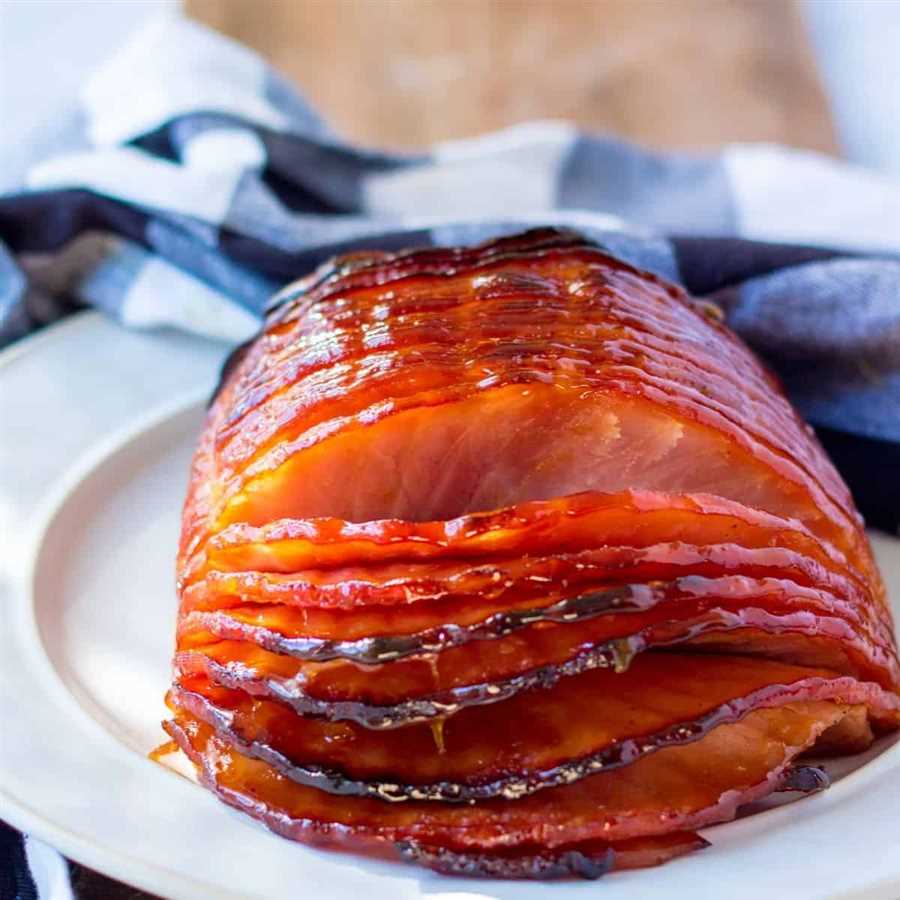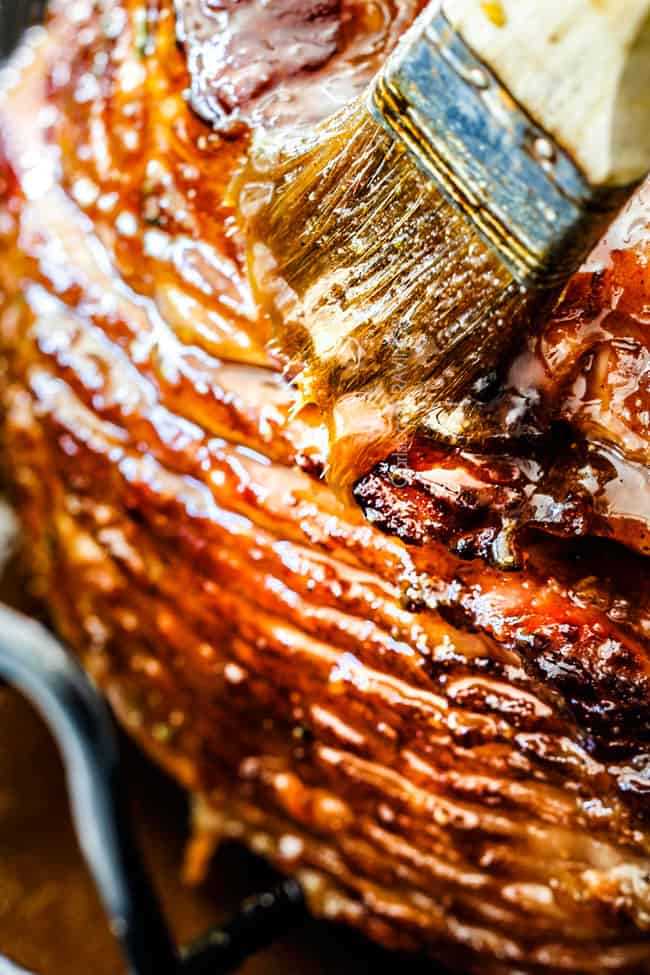Glazing the ham before cooking is a popular technique that enhances the flavor and visual appeal of this classic dish. While it is not necessary to glaze the ham before cooking, doing so adds a delicious, caramelized outer layer that complements the tender meat inside.
A glaze is typically a mixture of ingredients that are brushed or poured over the ham during the cooking process. This glaze can be sweet, savory, or a combination of both, depending on personal preference. Common ingredients used in glazes include sugar, honey, maple syrup, mustard, and various spices.
Glazing the ham helps to create a beautiful golden brown color on the outside, while also sealing in moisture and adding a delightful sweetness to the overall taste.
The glaze forms a sticky, flavorful crust that caramelizes as the ham cooks, resulting in a deliciously crisp exterior that contrasts with the tender, juicy meat.
While glazing is often associated with baked hams, it can also be used for other cooking methods such as grilling or smoking. Regardless of the cooking method, glazing can take your ham to the next level of flavor and presentation, making it a popular choice for holiday meals and special occasions.
Is it necessary to glaze the ham before cooking?
Glazing the ham before cooking is a personal preference and depends on the desired flavor and presentation of the dish. While glazing can enhance the taste and appearance of the ham, it is not necessary for cooking it.
Glazing involves applying a mixture of sugar, honey, or other ingredients onto the ham’s surface. As the ham cooks, the glaze caramelizes and forms a flavorful coating on the meat.
Some people prefer to glaze their hams as it adds sweetness and depth to the overall taste. The glaze can also create an attractive, glossy finish on the ham, making it visually appealing.
However, others may choose to skip the glazing step and cook their ham without it. This can be done for various reasons, such as a desire for a more savory or less sweet flavor. Additionally, skipping the glaze can save time and effort in the cooking process.
If you decide to glaze your ham, there are numerous glaze recipes available to suit different tastes. Popular options include maple glaze, brown sugar glaze, and mustard glaze. These glazes can incorporate additional flavors such as spices, herbs, or citrus zest to further enhance the ham’s taste.
| Pros of glazing the ham: | Cons of glazing the ham: |
|---|---|
| – Adds sweetness and flavor – Enhances the appearance – Creates a caramelized coating |
– Can make the ham too sweet for some – Adds extra time and effort – Not necessary for cooking |
In conclusion, while glazing the ham before cooking can add sweetness and visual appeal, it is not necessary. The decision to glaze or not glaze depends on personal preference and desired flavor profiles. Whether you choose to glaze your ham or not, the most important factors are to ensure it is cooked to the appropriate internal temperature and to enjoy the delicious end result.
Why glazing the ham enhances its flavor

Glazing a ham is a wonderful way to enhance its flavor and presentation. The process of glazing involves applying a sweet or savory sauce to the surface of the ham before cooking, which creates a beautiful caramelized crust and adds a burst of flavor to every bite.
Here are a few reasons why glazing the ham is highly recommended:
- Enhanced sweetness: The glaze, typically made with ingredients like honey, brown sugar, or maple syrup, adds a delightful sweetness to the ham. As the glaze cooks, it caramelizes and forms a shiny, sticky coating that imparts a rich flavor profile.
- Improved tenderness: The sugars in the glaze help to tenderize the meat by breaking down its proteins. This results in a ham that is juicy, succulent, and easy to slice.
- Contrasting flavors: Glazes can be customized to match your taste preferences, allowing you to experiment with different flavor combinations. Whether you prefer a tangy mustard glaze or a fruity pineapple glaze, the options are endless.
- Eye-catching presentation: Glazed hams are visually appealing, thanks to the glossy and caramelized exterior. The color and shine of the glaze make the ham a centerpiece on any holiday table, elevating the overall dining experience.
Glazing a ham before cooking is a simple yet effective way to elevate its taste and appearance. Whether you’re preparing a ham for a special occasion or just want to add a touch of indulgence to a regular meal, glazing is definitely worth considering.
The importance of a delicious glaze
A delicious glaze is the finishing touch that can elevate a simple ham into a mouth-watering centerpiece for any meal. Not only does it add a beautiful shine to the ham, but it also adds a burst of flavor that compliments the rich and tender meat.
One of the main benefits of glazing a ham before cooking is that it helps to seal in the moisture, ensuring that the meat remains juicy and succulent. As the glaze caramelizes in the oven, it creates a beautiful crust that locks in the natural flavors of the ham.
A well-crafted glaze can also provide a delightful contrast to the saltiness of the ham. Whether you choose a sweet glaze with ingredients like brown sugar and honey, or a tangy glaze with mustard and vinegar, the flavors will combine to create a harmonious balance that will leave your taste buds wanting more.
Not only does a glaze enhance the flavor of the ham, but it also adds visual appeal to the dish. When the ham is presented with a shiny, caramelized glaze, it becomes an eye-catching centerpiece that is guaranteed to impress your guests.
In conclusion, glazing a ham before cooking is a crucial step that should not be overlooked. The glaze not only seals in the moisture and enhances the flavor of the ham, but it also adds aesthetic appeal to the dish. So next time you cook a ham, take the time to create a delicious glaze that will truly elevate your meal to the next level.
How to make the perfect glaze for your ham

Glazing a ham can take it from ordinary to extraordinary. The sweet and sticky glaze creates a caramelized and flavorful crust on the outside of the ham, making it a show-stopping centerpiece for any holiday or special occasion. Here is a step-by-step guide on how to make the perfect glaze for your ham.
Ingredients
To make the perfect glaze, you’ll need the following ingredients:
| Ingredient | Quantity |
|---|---|
| Brown sugar | 1 cup |
| Honey | 1/4 cup |
| Dijon mustard | 2 tablespoons |
| Apple cider vinegar | 2 tablespoons |
| Ground cloves | 1/4 teaspoon |
Instructions
- Preheat your oven to the recommended temperature for cooking the ham.
- In a small saucepan, combine the brown sugar, honey, Dijon mustard, apple cider vinegar, and ground cloves.
- Place the saucepan over medium heat and stir the mixture until the sugar has dissolved and the glaze is smooth.
- Once the glaze is ready, remove the saucepan from heat and let it cool for a few minutes.
- Take your ham and score the surface with shallow cuts in a diamond pattern.
- Brush the glaze evenly over the ham, making sure to get it into the scored cuts.
- Place the glazed ham into a baking dish or roasting pan and cover it with aluminum foil.
- Bake the ham according to the recommended cooking time, removing the foil during the last 30 minutes to allow the glaze to caramelize.
- Once the ham is cooked, remove it from the oven and let it rest for about 15 minutes before serving.
Now you have all the knowledge to make the perfect glaze for your ham. Enjoy the deliciously sweet and sticky crust that will elevate your ham to new levels of flavor!
Tips for glazing the ham like a pro
Glazing a ham is a wonderful way to add flavor and a beautiful, caramelized finish to the meat. Whether you’re preparing a ham for a special occasion or just want to elevate your weeknight dinner, here are some tips to help you glaze the ham like a pro:
1. Choose the right glaze
There are countless glaze recipes out there, so choose one that complements the flavor of your ham. Popular options include honey mustard, brown sugar and pineapple, or maple and Dijon mustard. Experiment with different flavors to find your favorite combination.
2. Prepare the ham
Before applying the glaze, make sure your ham is prepped and ready to go. Remove any packaging, rinse the ham under cold water, and pat it dry with paper towels. Trim off excess fat if desired, but leave a thin layer to enhance the flavor and juiciness of the meat.
3. Score the ham
Scoring the ham not only adds a decorative touch, but it also allows the glaze to penetrate the meat and create a delicious caramelized crust. Use a sharp knife to make shallow cuts in a diamond or crisscross pattern. Be sure not to cut too deep, as you don’t want the ham to dry out during cooking.
4. Apply the glaze
Generously brush the glaze all over the ham, making sure to get into the cuts you made. Use a basting brush or simply pour the glaze over the ham and spread it evenly. For extra flavor, baste the ham with the glaze every 20-30 minutes while it cooks.
Note: If using a sticky glaze, such as honey or maple syrup, it’s best to apply it during the last 30 minutes of cooking to prevent it from burning.
5. Cook the ham
Follow the instructions on the packaging for cooking times and temperatures. In general, most hams should be cooked in a preheated oven at 325°F (163°C). It’s important to use a meat thermometer to ensure the ham reaches an internal temperature of 145°F (63°C) for proper cooking.
6. Let it rest
After removing the ham from the oven, let it rest for about 10-15 minutes before carving. This allows the juices to redistribute and ensures a moist and flavorful ham.
With these tips in mind, you’ll be able to glaze the ham like a pro and impress your family and friends with a delicious centerpiece for your meal.
Questions and answers
Should I glaze the ham before cooking?
Yes, glazing the ham before cooking helps to enhance its flavor and appearance.
What is glazing and why is it important for a ham?
Glazing is the process of applying a sweet or savory coating to the surface of the ham before cooking. It is important because it adds flavor, moisture, and a beautiful caramelized appearance to the ham.
What are some popular glaze options for hams?
Some popular glaze options for hams include honey mustard glaze, brown sugar glaze, pineapple glaze, and maple glaze.
When should I apply the glaze to the ham?
You should apply the glaze to the ham during the last 30 minutes to 1 hour of cooking. This allows the glaze to caramelize without burning.
Can I make a glaze with alcohol for my ham?
Yes, you can make a glaze with alcohol for your ham. Some popular options include bourbon glaze, rum glaze, and wine glaze. However, make sure to cook the ham long enough to burn off the alcohol content.
Why is it important to glaze the ham before cooking?
Glazing the ham before cooking helps to enhance its flavor and appearance. The glaze caramelizes and forms a delicious crust on the ham, while also adding a sweet or savory element to the dish.






